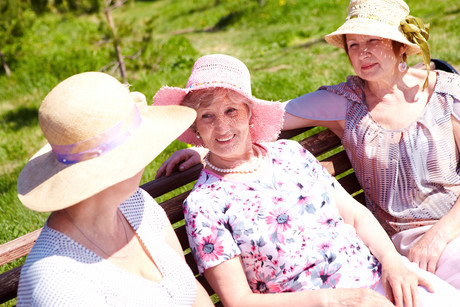Your daily dose of D

Many healthcare workers and patients, particularly the elderly, spend a great deal of time indoors. How does this impact their vitamin D levels? How much sun is enough for Vitamin D?
With summer finally upon us, many Australians are flocking outdoors to get their vitamin D fix from the sun. But with summer UV levels strong enough to damage skin in just 15 minutes, it’s important for people to understand how much sun is healthy.
The basics of UV
The sun’s ultraviolet (UV) radiation is a form of energy produced by the sun. UV radiation triggers the process for bodies to produce vitamin D, which is important for healthy bones and muscles. However, UV can also damage DNA and is the major cause of skin cancer in Australia. It also causes sunburn, tanning and premature ageing.
UV is not like the sun’s light, which we feel, or the sun’s heat, which we can see. In fact, none of our senses can detect UV radiation. But, because UV is strongest in the hot summer months, we mistakenly associate sunburn and skin damage with temperature.
The strength of UV is important, because it helps us determine when we need protection and when it is low enough that we can safely expose our skin for a fix of ‘guilt-free UV’.
UV levels and sun protection
Following the World Health Organization guidelines, sun protection is recommended for all skin types whenever the UV levels are 3 or higher. This means a combination of measures:
- Covering clothing,
- SPF30 (or higher) broad-spectrum, water-resistant sunscreen.
- A broad-brimmed hat.
- Seeking shade.
- Sunglasses.
Check UV levels and the times of day sun protection is recommended for your location on the free SunSmart app or on the Bureau of Meteorology’s website.
How much sun is enough for vitamin D?
Because UV levels are so strong in the Australian summer, most people will make enough vitamin D by spending a few minutes outdoors on most days of the week.
However, from May to mid-August in southern parts of Australia, the UV levels fall below 3 on most days. At this time of year, sun protection isn’t required, and people should spend time outdoors in the middle of the day with some skin uncovered. Being physically active can also help maintain vitamin D levels. Studies show that good sun protection will not put you at risk of vitamin D deficiency.
What about vitamin D deficiency?
Based on current evidence, a sufficient level of vitamin D for bone health is 50–60 nmol/L. However, vitamin D levels change naturally with the seasons, so it can be normal for most people to have a dip in vitamin D in winter, with levels increasing again in the summer months.
However, some people are at increased risk of vitamin D deficiency (levels of <50 nmol/L). Rather than risk skin cancer, it is recommended anyone in these high-risk groups speak to their GP for advice about supplementation. This includes:
- people with naturally very dark skin — this is because the pigment (melanin) in dark skin doesn’t absorb as much UV radiation;
- people who avoid the sun due to previous skin cancers, immune suppression or sensitive skin and those who have limited sun exposure, such as nightshift workers;
- people who wear covering or concealing clothing;
- people who spend a long time indoors, such as those who are housebound or institutionalised;
- people who are obese or have disabilities, diseases or medications that affect vitamin D metabolism, including end-stage liver disease, renal disease and fat malabsorption syndromes such as cystic fibrosis, coeliac disease, inflammatory bowel disease;
- breast-fed babies of vitamin D-deficient mothers (formula milk is fortified with vitamin D).
Overexposing your skin to UV radiation from the sun is never recommended, even if you are vitamin D deficient.
Learn more
ThinkGP and Cancer Council Victoria have partnered to create a learning module on skin cancer prevention and vitamin D. The module is accredited with RACGP (2 points) and ACRRM (1 point). Visit thinkgp.com.au for more information.
You can also visit the health professionals page at sunsmart.com.au for resources and more information.
**************************************************
Skin cancer statistics
- 2 in 3 Australians will be diagnosed with skin cancer by the age of 70.
- More than 2000 people die from skin cancer in Australia every year.
- More than 2500 basal and squamous cell carcinomas are treated every day.
- Between 95% and 99% of skin cancers are caused by UV damage and can be prevented by using good sun protection when the UV levels are 3 or higher.
**************************************************

Could this tailored heart pump transform care for half of heart failure patients?
Half of the 64 million people living with heart failure have no access to heart pump treatments....
Breastfeeding challenges healthcare professionals should be prepared to address
A neonatal nurse and lactation consultant sets out what she sees as the most common breastfeeding...
Framework seeks to cut medicine errors at transitions of care
The first coordinated, hospital-based approach to medication management at transitions of care...






![[New Zealand] Transform from Security Awareness to a Security Culture: A Vital Shift for SMB Healthcare — Webinar](https://d1v1e13ebw3o15.cloudfront.net/data/89856/wfmedia_thumb/..jpg)
![[Australia] Transform from Security Awareness to a Security Culture: A Vital Shift for SMB Healthcare — Webinar](https://d1v1e13ebw3o15.cloudfront.net/data/89855/wfmedia_thumb/..jpg)




